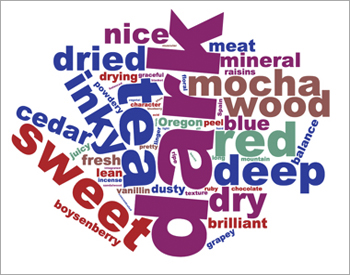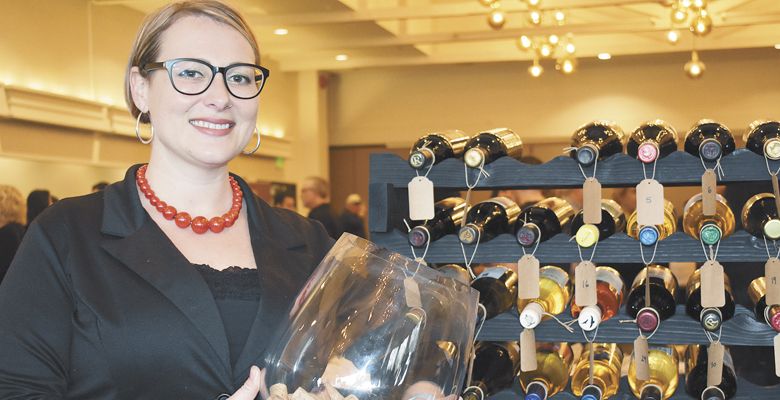Raising the Temp
Oregon Tempranillo continues to catch fire
With notes of dark red fruit, oak and subtle spice, not to mention superbly balanced and full of character, Oregon Tempranillo has become a wine to treasure. So much so, the fourth annual Oregon Tempranillo Celebration continues its efforts, this year showcasing 48 exceptional wines from 24 wineries, Jan. 18–20 in Ashland.
More than 250 industry leaders, vintners, winemakers and fans gathered to learn about and enjoy the many fine Tempranillos via technical seminars, comparative tastings, sensory analyses, reviews by expert judges and pretty pours.
One of the great advantages of experiencing the varietal at the Oregon Tempranillo Celebration is to do so surrounded by knowledgeable palates and the opportunity to taste Tempranillos from different Oregon AVAs, as well as compare them to those produced in Spain.
Nora Lancaster, Kriselle Cellars’ director of sales, relays the Oregon Tempranillo story often. “Tempranillo means ‘early ripening’ [and] so the varietal avoids the threat of fall frost and grows in every AVA in the state,” she explained. “It’s a rich, food-friendly wine with a place at almost every table.” She’s observed that consumer recognition of the varietal has increased over the last decade.
Producer interest has risen, too. In 2017, 368 Oregon acres were planted to Tempranillo with the greatest numbers in the Umpqua and Rogue valleys; yield measured about 1,011 tons with a price per ton of $1,994. For purposes of comparison, the Oregon Wine Board reports Pinot Noir was planted to 19,697 acres in 2017, yielding 53,457 tons, selling at $2,375 per ton.

Saturday’s agenda focused on the unique aspects of growing quality Tempranillo, producing exceptional wines and bringing the wine to market. The day started in the vineyard, so to speak, with topics like trellising, canopy management, ground covers and dry farming methods, generating plenty of exchanges among growers. The seminar continued with consumer perceptions and branding, and how the varietal is poised to move strongly in the market. Lunchtime offered guests a blind tasting from varying Oregon AVAs, and the afternoon sessions concerned winemaking, with a comparative tasting of Oregon and Spanish Tempranillos.
Sunday afternoon’s open event welcomed hundreds of tasters, curious about Tempranillo and the wineries that produced them.
Evaluating all wines submitted were three experts: Bree Boskov, Master of Wine and Oregon Wine Board educator; Mike Dunn, a long-time wine writer and frequent wine competition judge; and Alder Yarrow, founder and editor of vinography.com.
Yarrow described the Tempranillos he tasted as dark, meaty and full of black fruit. He combined the notes of the three judges to produce a word cloud, a novel approach to illustrating the flavors of the wine. The visual exercise demonstrated the consistency and range of their impressions. Words like “dark,” “inky,” “sweet” and “tea” predominated, and notes such as “raisin,” “boysenberry” and “chocolate” were also present among many other descriptors.
Boskov described typical Spanish Tempranillos as wines made in styles based on aging and release. She explained that many of the Oregon Tempranillos she tasted were consistently aged for 12 or more months. Both Boskov and Yarrow noted local winemakers could have a new market with an early-release Tempranillo. “There’s an opportunity to widen the stylist interpretation of the grape, in particular the young fresh approach could be very interesting,” Yarrow said. “Especially if it could be done at a lower price point, which would open it up to wines sold by the glass and be a different style of the wine.”
Established Oregon growers and producers of Tempranillo wines are clear in their understanding of how this varietal can be expressed with different styles. In the Umpqua, Abacela produces seven different Tempranillos; while Red Lily in the Applegate focuses exclusively on the Spanish-style varietal, producing six different Tempranillo-based wines.
“Tempranillo can express itself in different ways, and we’re showing the depth of those wines,” said Red Lily winemaker Rachel Martin. “We have the ripening potential to do almost anything we want with that grape, and that’s its magic. When you are producing predominantly Tempranillo wines, it’s important that they’re different; some are a more lighter-bodied wine — a gateway wine — and some are heavy-hitting, really structured tannic wines that are aged.”
The date and location for the 2019 Oregon Tempranillo Celebration has not yet been determined. Eric Weisinger, Weisinger Family Winery; Chris Castillo, Castillo de Feliciana Vineyard and Winery; Les Martin, Red Lily Vineyards; and Debbie Schultz, Schultz Glory Oaks Vineyard and Farm, serve respectively as president, vice president, treasurer and secretary of the Oregon Tempranillo Alliance, which serves 39 member wineries as of the article’s publication.











